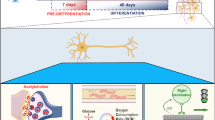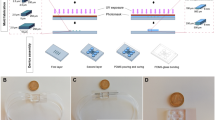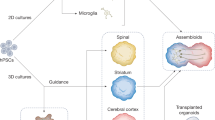Abstract
The compartmented culture, in which primary neurons plated in a proximal compartment send their axons under silicone grease barriers and into left and right distal compartments, has enhanced the experimental capabilities of neuronal cultures. Treatments can be applied separately to cell bodies/proximal axons or distal axons, and cell bodies/proximal axons and distal axons can be separately harvested and analyzed. Distal axons can be axotomized, and the neurons can be studied while their axons regenerate. Construction of the culture dishes requires 3 h for 48 cultures, and preparing the neurons also requires 3 h. Compartmented cultures provide enough cellular material for biochemical analyses such as immunoblotting. The uses of compartmented cultures have included studies of neurotrophic factor retrograde signaling, axonal transport, and axonal protein and lipid biosynthesis. Here we focus on sympathetic neurons cultured from neonatal rats and provide protocols for the production and some of the uses of compartmented cultures.
This is a preview of subscription content, access via your institution
Access options
Subscribe to this journal
Receive 12 print issues and online access
$259.00 per year
only $21.58 per issue
Buy this article
- Purchase on Springer Link
- Instant access to full article PDF
Prices may be subject to local taxes which are calculated during checkout







Similar content being viewed by others
References
Campenot, R.B. Local control of neurite development by nerve growth factor. Proc. Natl. Acad. Sci. USA 74, 4516–4519 (1977).
Campenot, R.B. Development of sympathetic neurons in compartmentalized cultures. II. Local control of neurite survival by nerve growth factor. Dev. Biol. 93, 13–21 (1982).
Campenot, R.B. Development of sympathetic neurons in compartmentalized cultures. I. Local control of neurite growth by nerve growth factor. Dev. Biol. 93, 1–12 (1982).
MacInnis, B.L. & Campenot, R.B. Retrograde support of neuronal survival without retrograde transport of nerve growth factor. Science 295, 1536–1539 (2002).
Mok, S.A., Lund, K. & Campenot, R.B. A retrograde apoptotic signal originating in NGF-deprived distal axons of rat sympathetic neurons in compartmented cultures. Cell Res. 19, 546–560 (2009).
Senger, D.L. & Campenot, R.B. Rapid retrograde tyrosine phosphorylation of trkA and other proteins in rat sympathetic neurons in compartmented cultures. J. Cell. Biol. 138, 411–421 (1997).
MacInnis, B.L., Senger, D.L. & Campenot, R.B. Spatial requirements for TrkA kinase activity in the support of neuronal survival and axon growth in rat sympathetic neurons. Neuropharmacology 45, 995–1010 (2003).
Mok, S.A. & Campenot, R.B. A nerve growth factor-induced retrograde survival signal mediated by mechanisms downstream of TrkA. Neuropharmacology 52, 270–278 (2007).
Eng, H., Lund, K. & Campenot, R.B. Synthesis of beta-tubulin, actin, and other proteins in axons of sympathetic neurons in compartmented cultures. J. Neurosci. 19, 1–9 (1999).
Vance, J.E., Pan, D., Campenot, R.B., Bussiere, M. & Vance, D.E. Evidence that the major membrane lipids, except cholesterol, are made in axons of cultured rat sympathetic neurons. J. Neurochem. 62, 329–337 (1994).
Campenot, R.B., Lund, K. & Senger, D.L. Delivery of newly synthesized tubulin to rapidly growing distal axons of sympathetic neurons in compartmented cultures. J. Cell. Biol. 135, 701–709 (1996).
Ure, D.R. & Campenot, R.B. Retrograde transport and steady-state distribution of 125I-nerve growth factor in rat sympathetic neurons in compartmented cultures. J. Neurosci. 17, 1282–1290 (1997).
Walicke, P.A., Campenot, R.B. & Patterson, P.H. Determination of transmitter function by neuronal activity. Proc. Natl. Acad. Sci. USA 74, 5767–5771 (1977).
Singh, K.K. & Miller, F.D. Activity regulates positive and negative neurotrophin-derived signals to determine axon competition. Neuron. 45, 837–845 (2005).
Kimpinski, K., Campenot, R.B. & Mearow, K. Effects of the neurotrophins nerve growth factor, neurotrophin-3, and brain-derived neurotrophic factor (BDNF) on neurite growth from adult sensory neurons in compartmented cultures. J. Neurobiol. 33, 395–410 (1997).
Watson, F.L. et al. Rapid nuclear responses to target-derived neurotrophins require retrograde transport of ligand–receptor complex. J. Neurosci. 19, 7889–7900 (1999).
Hayashi, H., Campenot, R.B., Vance, D.E. & Vance, J.E. Glial lipoproteins stimulate axon growth of central nervous system neurons in compartmented cultures. J. Biol. Chem. 279, 14009–14015 (2004).
Watson, F.L. et al. Neurotrophins use the Erk5 pathway to mediate a retrograde survival response. Nat. Neurosci. 4, 4 (2001).
Ye, H., Kuruvilla, R., Zweifel, L.S. & Ginty, D.D. Evidence in support of signaling endosome-based retrograde survival of sympathetic neurons. Neuron. 39, 57–68 (2003).
Campenot, R.B. NGF uptake and retrograde signaling mechanisms in sympathetic neurons in compartmented cultures. in Results and Problems in Cell Differentiation, Vol. 48 Cell Biology of the Axon (ed. Koenig, E.) 141–158 (Springer, Berlin/Heidelberg, 2009).
Zweifel, L.S., Kuruvilla, R. & Ginty, D.D. Functions and mechanisms of retrograde neurotrophin signalling. Nat. Rev. Neurosci. 6, 615–625 (2005).
Ginty, D.D. & Segal, R.A. Retrograde neurotrophin signaling: Trk-ing along the axon. Curr. Opin. Neurobiol. 12, 268–274 (2002).
Campenot, R.B. & MacInnis, B.L. Retrograde transport of neurotrophins: fact and function. J. Neurobiol. 58, 217–229 (2004).
Campenot, R.B. & Eng, H. Protein synthesis in axons and its possible functions. J. Neurocytol. 29, 793–798 (2000).
Vance, J.E., Campenot, R.B. & Vance, D.E. The synthesis and transport of lipids for axonal growth and nerve regeneration. Biochim. Biophys. Acta 1486, 84–96 (2000).
Bertrand, J., Winton, M.J., Rodriguez-Hernandez, N., Campenot, R.B. & McKerracher, L. Application of rho antagonist to neuronal cell bodies promotes neurite growth in compartmented cultures and regeneration of retinal ganglion cell axons in the optic nerve of adult rats. J. Neurosci. 25, 1113–1121 (2005).
Yang, X.M. et al. Autocrine hepatocyte growth factor provides a local mechanism for promoting axonal growth. J. Neurosci. 18, 8369–8381 (1998).
Chu, G.K. & Tator, C.H. Calcium influx is necessary for optimal regrowth of transected neurites of rat sympathetic ganglion neurons in vitro . Neuroscience 102, 945–957 (2001).
Song, M.S., Saavedra, L. & de Chaves, E.I. Apoptosis is secondary to non-apoptotic axonal degeneration in neurons exposed to Abeta in distal axons. Neurobiol. Aging 27, 1224–1238 (2006).
Ch′ng, T.H. & Enquist, L.W. Neuron-to-cell spread of pseudorabies virus in a compartmented neuronal culture system. J. Virol. 79, 10875–10889 (2005).
Ch′ng, T.H., Spear, P.G., Struyf, F. & Enquist, L.W. Glycoprotein D-independent spread of pseudorabies virus infection in cultured peripheral nervous system neurons in a compartmented system. J. Virol. 81, 10742–10757 (2007).
Manning, P.T., Johnson, E.M., Jr., Wilcox, C.L., Palmatier, M.A. & Russell, J.H. MHC-specific cytotoxic T lymphocyte killing of dissociated sympathetic neuronal cultures. Am. J. Pathol. 128, 395–409 (1987).
Pazyra-Murphy, M.F. & Segal, R.A. Preparation and maintenance of dorsal root ganglia neurons in compartmented cultures. J. Vis. Exp. published online, doi: 10.3791/951 (17 October 2008).
Cui, B. et al. One at a time, live tracking of NGF axonal transport using quantum dots. Proc. Natl. Acad. Sci. USA 104, 13666–13671 (2007).
Heerssen, H.M. & Segal, R.A. Location, location, location: a spatial view of neurotrophin signal transduction. Trends Neurosci. 25, 160–165 (2002).
Heerssen, H.M., Pazyra, M.F. & Segal, R.A. Dynein motors transport activated Trks to promote survival of target-dependent neurons. Nat. Neurosci. (2004).
Carlton, E. et al. Fusion of the tetanus toxin C fragment binding domain and Bcl-xL for protection of peripheral nerve neurons. Neurosurgery 63, 1175–1182; discussion 1182–1184 (2008).
Ng, B.K., Chen, L., Mandemakers, W., Cosgaya, J.M. & Chan, J.R. Anterograde transport and secretion of brain-derived neurotrophic factor along sensory axons promote Schwann cell myelination. J. Neurosci. 27, 7597–7603 (2007).
Bi, J., Tsai, N.P., Lin, Y.P., Loh, H.H. & Wei, L.N. Axonal mRNA transport and localized translational regulation of kappa-opioid receptor in primary neurons of dorsal root ganglia. Proc. Natl. Acad. Sci. USA 103, 19919–19924 (2006).
Bi, J., Tsai, N.P., Lu, H.Y., Loh, H.H. & Wei, L.N. Copb1-facilitated axonal transport and translation of kappa opioid-receptor mRNA. Proc. Natl. Acad. Sci. USA 104, 13810–13815 (2007).
Copray, S., Liem, R., Mantingh-Otter, I.J. & Brouwer, N. Coculture of rat embryonic proprioceptive sensory neurons and myotubes. Muscle Nerve 19, 1401–1412 (1996).
Silva, A., Wang, Q., Wang, M., Ravula, S.K. & Glass, J.D. Evidence for direct axonal toxicity in vincristine neuropathy. J. Peripher. Nerv. Syst. 11, 211–216 (2006).
Melli, G., Keswani, S.C., Fischer, A., Chen, W. & Hoke, A. Spatially distinct and functionally independent mechanisms of axonal degeneration in a model of HIV-associated sensory neuropathy. Brain 129, 1330–1338 (2006).
Guertin, A.D., Zhang, D.P., Mak, K.S., Alberta, J.A. & Kim, H.A. Microanatomy of axon/glial signaling during Wallerian degeneration. J. Neurosci. 25, 3478–3487 (2005).
Edstrom, A. & Ekstrom, P.A. Role of phosphatidylinositol 3-kinase in neuronal survival and axonal outgrowth of adult mouse dorsal root ganglia explants. J. Neurosci. Res. 74, 726–735 (2003).
Kimpinski, K., Jelinski, S. & Mearow, K. The anti-p75 antibody, MC192, and brain-derived neurotrophic factor inhibit nerve growth factor-dependent neurite growth from adult sensory neurons. Neuroscience 93, 253–263 (1999).
Tsiang, H., Ceccaldi, P.E. & Lycke, E. Rabies virus infection and transport in human sensory dorsal root ganglia neurons. J. Gen. Virol. 72 (Part 5): 1191–1194 (1991).
Lycke, E. & Tsiang, H. Rabies virus infection of cultured rat sensory neurons. J. Virol. 61, 2733–2741 (1987).
Ekstrom, P.A., Bergstrand, H. & Edstrom, A. Effects of protein kinase inhibitors on regeneration in vitro of adult frog sciatic sensory axons. J. Neurosci. Res. 31, 462–469 (1992).
Ekstrom, P.A. Insulin stimulates ganglionic protein synthesis and reduces thymidine incorporation in support cells of the in vitro regenerating adult frog sciatic sensory neurons. Neurosci. Lett. 132, 183–186 (1991).
Ivins, K.J., Bui, E.T. & Cotman, C.W. Beta-amyloid induces local neurite degeneration in cultured hippocampal neurons: evidence for neuritic apoptosis. Neurobiol. Dis. 5, 365–378 (1998).
Underhill, S.M. & Goldberg, M.P. Hypoxic injury of isolated axons is independent of ionotropic glutamate receptors. Neurobiol. Dis. 25, 284–290 (2007).
Hayashi, H. et al. Methods for the study of lipid metabolism in neurons. Anal. Biochem. 331, 1–16 (2004).
Hayashi, H., Campenot, R.B., Vance, D.E. & Vance, J.E. Apolipoprotein E-containing lipoproteins protect neurons from apoptosis via a signaling pathway involving low-density lipoprotein receptor-related protein-1. J. Neurosci. 27, 1933–1941 (2007).
Sonderegger, P. et al. A few axonal proteins distinguish ventral spinal cord neurons from dorsal root ganglion neurons. J. Cell. Biol. 98, 364–368 (1984).
Klostermann, S. & Bonhoeffer, F. Investigations of signaling pathways in axon growth and guidance. Perspect. Dev. Neurobiol. 4, 237–252 (1996).
Brayfield, C.A., Marra, K.G., Leonard, J.P., Tracy Cui, X. & Gerlach, J.C. Excimer laser channel creation in polyethersulfone hollow fibers for compartmentalized in vitro neuronal cell culture scaffolds. Acta Biomater. 4, 244–255 (2008).
Bergen, J.M. & Pun, S.H. Analysis of the intracellular barriers encountered by nonviral gene carriers in a model of spatially controlled delivery to neurons. J. Gene Med. 10, 187–197 (2008).
Ravula, S.K., Wang, M.S., Asress, S.A., Glass, J.D. & Bruno Frazier, A. A compartmented neuronal culture system in microdevice format. J. Neurosci. Methods 159, 78–85 (2007).
Ravula, S.K., McClain, M.A., Wang, M.S., Glass, J.D. & Frazier, A.B. A multielectrode microcompartment culture platform for studying signal transduction in the nervous system. Lab. Chip 6, 1530–1536 (2006).
Liu, W.W., Goodhouse, J., Jeon, N.L. & Enquist, L.W. A microfluidic chamber for analysis of neuron-to-cell spread and axonal transport of an alpha-herpesvirus. PLoS ONE 3, e2382 (2008).
Taylor, A.M., Rhee, S.W. & Jeon, N.L. Microfluidic chambers for cell migration and neuroscience research. Methods. Mol. Biol. 321, 167–177 (2006).
Park, J.W., Vahidi, B., Taylor, A.M., Rhee, S.W. & Jeon, N.L. Microfluidic culture platform for neuroscience research. Nat. Protoc. 1, 2128–2136 (2006).
Campenot, R.B. Independent control of the local environment of somas and neurites. Methods Enzymol. 58, 302–307 (1979).
Campenot, R.B. Compartmented culture analysis of nerve growth. In Cell–Cell Interactions: A Practical Approach (eds. Stevenson, B.R., Gallin, W.J. & Paul, D.L.) 275–298 (IRL Press, Oxford, 1992).
Campenot, R.B. & Martin, G. Construction and use of compartmented cultures for studies of cell biology of neurons. In Protocols for Neural Cell Culture (eds. Federoff, S. & Richardson, A.) 49–57 (Humana Press, Totowa, New Jersey, 2001).
Hawrot, E. & Patterson, P.H. Long-term culture of dissociated sympathetic neurons. Methods Enzymol. 58, 574–584 (1979).
Mains, R.E. & Patterson, P.H. Primary cultures of dissociated sympathetic neurons. I. Establishment of long-term growth in culture and studies of differentiated properties. J. Cell. Biol. 59, 329–345 (1973).
Tsui-Pierchala, B.A. & Ginty, D.D. Characterization of an NGF-P-TrkA retrograde-signaling complex and age-dependent regulation of TrkA phosphorylation in sympathetic neurons. J. Neurosci. 19, 8207–8218 (1999).
Chun, L.L. & Patterson, P.H. Role of nerve growth factor in the development of rat sympathetic neurons in vitro. II. Developmental studies. J. Cell. Biol. 75, 705–711 (1977).
Acknowledgements
We thank the researchers who have worked in the laboratory and contributed improvements to our techniques over the years: Dr. Daren Ure, Dr. Donna Senger, Grace Martin, Russell Watts, Dr. Bronwyn MacInnis, Norma Jean Valli and Dr. Barbara Karten. Special thanks to Dr. Edwin Furshpan and Dr. David Potter in whose laboratory R.B.C. developed the compartmented culture during a postdoctoral fellowship in 1976–1978. Work contributing to the development and refinement of the techniques described here has been funded by The National Institutes of Health (USA), The Canadian Institutes of Health Research, The Alberta Heritage Foundation for Medical Research, The Alberta Paraplegic Foundation and the Rick Hansen Man in Motion Foundation.
Author information
Authors and Affiliations
Contributions
All authors contributed extensively to the development of this protocol and preparation of the paper. K.L. developed several of the procedures and prepared a laboratory manual upon which much of the detail in the protocol is based; S.-A.M. developed several of the procedures, created the graphic images and prepared part of the initial draft of the paper; R.B.C. originally developed the compartmented culture system, produced most of the photographs and wrote the final paper.
Corresponding author
Rights and permissions
About this article
Cite this article
Campenot, R., Lund, K. & Mok, SA. Production of compartmented cultures of rat sympathetic neurons. Nat Protoc 4, 1869–1887 (2009). https://doi.org/10.1038/nprot.2009.210
Published:
Issue Date:
DOI: https://doi.org/10.1038/nprot.2009.210
This article is cited by
-
Active acetylcholine receptors prevent the atrophy of skeletal muscles and favor reinnervation
Nature Communications (2020)
-
c-Jun N-terminal kinase (JNK)-dependent internalization and Rab5-dependent endocytic sorting mediate long-distance retrograde neuronal death induced by axonal BDNF-p75 signaling
Scientific Reports (2019)
-
FAIM-L regulation of XIAP degradation modulates Synaptic Long-Term Depression and Axon Degeneration
Scientific Reports (2016)
-
Addition of exogenous α-synuclein preformed fibrils to primary neuronal cultures to seed recruitment of endogenous α-synuclein to Lewy body and Lewy neurite–like aggregates
Nature Protocols (2014)
-
Coculture Model of Sensory Neurites and Keratinocytes to Investigate Functional Interaction: Chemical Stimulation and Atomic Force Microscope–Transmitted Mechanical Stimulation Combined with Live-Cell Imaging
Journal of Investigative Dermatology (2013)
Comments
By submitting a comment you agree to abide by our Terms and Community Guidelines. If you find something abusive or that does not comply with our terms or guidelines please flag it as inappropriate.



